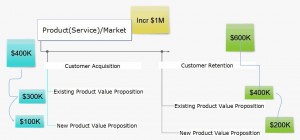Increasing or sometimes just maintaining sales is a major challenge for a company these days. Many companies will receive an edict that we want to increase sales 10% this year. But really how are you going to do that? The mechanics are one thing. Gaining consensus and understanding is a totally different thing and maybe your biggest stumbling block.
The central theme of 5Cs of Driving Market Share is to provide a direct line of sight to customer value. That line of sight is actually from the customer’s point of view. I am going to walk you through the program mostly for the reason to explain the diagram I have included for you to demonstrate how and where you increase in market share will come from.
The first things we do in the program is identify your customer buying segments, the product/market relationship that exist and where you most profitable market opportunities are. It is based on not only how your customer defines value but also how the market defines value. We take this knowledge and identify competitive value and performance gaps that enable you to create and implement the processes that we think are needed to reach the targeted goal. This is basically the Plan and Do phase of a PDCA cycle.
After implementing the initial efforts, we Check (phase) those efforts to against the targeted gap. If they have been met, we continue to the Act Stage and standardize the process and move forward. If they are not, we return to the Plan phase and start the cycle over.
I know this sounds simple and to a certain extent it is. Most of us complicate much of it with shortcuts and a lack of true understanding of customer value. We just don’t take the time in the planning phase that is required. However, I want to use this explanation to discuss what is needed in gaining market share. Simple or not, few companies can really define correctly how the customer and market views the value that they add and are willing to spend money for.
Most companies seldom have one value stream. They will have numerous ones based on Customer Segments and product/markets. After analysis many times these segments and product/markets are reduced to a critical few. We don’t walk away from all the others but our focus and energies go towards what is paying the bills now and in the future.
These models can be used to determine quite easily what efforts and budgets must be created to increase market share. For example, if we have one very significant product (service)/market and our best opportunities are in that area, we may dedicate 50, 60 percent of our marketing budget and resources to it.
In the picture I show that the gap we are trying to increase or maintain is 1 million dollars. Through analysis utilizing tools opportunity and loyalty matrices for example we divide the dollars up between customer retention and acquisition. We then take a look at dividing that again by utilizing your existing value proposition and maybe a new product innovation proposition. We can further divide these up as we dig deeper into our customer segments or product/market. Just utilizing a very simplified value stream such as this it starts giving you a feel for how you will increase sales. As you drill down through these various stages, you also become much more targeted and focused on what your customer values.
As you drill down and segment your list don’t just think about percentages of budgets and resources. Using real $ if you can versus %. It not only adds more meaning to the conversation but when you start looking at your expectations from customer segments and the value proposition you are offering them, well are you being realistic?
This is where continuous improvement efforts, PDCA and A3 problem solving come to the forefront. Starting A3 before you drill down into a very tight cycle is useless. Your efforts will not be defined enough to pay off.
Some Potential A3’s that may come out of this exercise would be:
- Reducing churn (Customer loyalty matrix)
- Focusing on most important customers for growth (P/M Matrix)
- Loyalty of customers (Customer loyalty matrix)
- Brand’s value proposition (Value matrix)
- Competitor vulnerability (Competitive vulnerability matrix)
- Targeting markets (market opportunity matrix)
- Identifying people product and processes for improvement
Related Information:
5 Cs of Driving Market Share
Apply Lean thinking to Sales and Marketing
Marketing with A3s
Lean Marketing House & Marketing with A3, LTD Time offer
Profound knowledge for Lean Marketing
Six Sigma Marketing/Modified DMAIC

